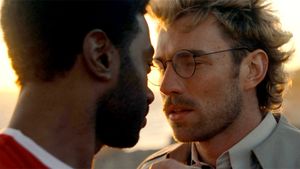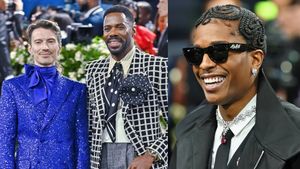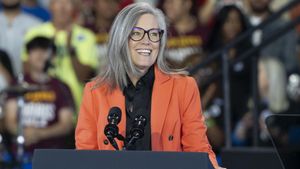According to Merriam-Webster’s dictionary, an album is a collection of songs, but it is also “a book with blank pages used for making a collection.” And that is the definition that most intrigues for our purposes in compiling The Greatest Lesbian Albums (Of All Time) – the idea that a collection of recordings has the power to create an indelible impression on the listener.
While spectacularly crafted albums can elicit visceral responses from listeners universally, it feels even truer for the LGBT listener, who continually turns over a phrase, lyric, harmony to infer a sense of solidarity with the artist.
In endeavoring to nail down The 100 Greatest Lesbian Albums (Of All Time) we enlisted the help of lesbian friends, colleagues, musicians and entertainers spanning 6 decades in age and asked them to name the albums that provided the soundtrack to their lives as women.
With singer songwriters of the seventies, punk divas, new-wave goddesses, gutsy rockers, jazz chanteuses and synth pop darlings, please enjoy our list, continuing below with albums 75-51. We will roll out 25 each week until we hit number one, so if you don’t see your favorite album this week you may see it in the weeks to come, or in our first group of 100 - 76.
75. Nona Hendryx, Nona 1982
An original member of Labelle, which churned out the mega-hit “Lady Marmalade,” openly bisexual Hendryx ventured into solo territory in 1977 but she turned a corner with Nona. Hendyrx’s angular haircut fit the andro new wave era to a tee, and her synth/funk songs on Nona included the feminist-leaning “Transformations,” which played on an episode ofThe L Word.
74. Metric, Live It Out 2005
The Canadian band led by the incredibly sexy vocalist Emily Haines hit it big with their 3rd studio album. In addition to her solo career, Haines records and performs as a member of Metric and Broken Social Scene. Her sweet voice and big doe eyes drive all the indie rock girls crazy.
73. The Cranberries, Everybody Else Is Doing It, So Why Can't We? 1993
The first album from Irish rockers The Cranberries signaled the arrival of one of the most prolific songwriters of the early 90s, lead singer Dolores O’Riordon. She cowrote the album that spawned hits “Linger” and “Dreams." Her unique, impassioned vocals and poignant lyrics coupled with her pixie looks spoke to a lot of alternative ladies.
72. Missy Higgins, The Sound of White 2005
A beautiful Australian singer, songwriter and actress Higgins won a song recording competition and record contract while she was still in school. Critics and fans agreed that Higgins songs are “reminiscent of early Suzanne Vega and Sarah McLachlan” and that’s a very good thing. PS: Following speculation, she came out as a bisexual in 2007 but prefers the press to focus on her music.
71. Dixie Chicks, Wide Open Space 1998
Long before they weren't ready to Shut Up & Sing and make nice with President Bush three Texas blonds took over country music and converted pop fans across the world. The first album with lead singer Natalie Maines in the band was a huge commercial hit, collecting major awards and resonating for young women everywhere.
More on next page
\\\
continued
70. The Sundays, Blind 1992
Their cover of the Rolling Stones’ “Wild Horses” was the best make out song of the nineties—bar none. The album's dark and experimental dream pop vibe and front woman Harriet Wheeler's impassioned and unique vocals spoke to the girls who were feeling left out or out of place long before “emo” or “goth” were recognized trends.
69. Phranc, I Enjoy Being a Girl 1989
Phranc began her career in the New York punk scene but later self-identified as an “All-American Jewish Lesbian Folksinger” becoming a college radio station fave with her satirical songs including “Double Decker Bed." She went on to collaborate with Queercore musicians including Team Dresch.
68. Erykah Badu, Baduizm 1997
The First Lady of Neo-Soul, Erykah Badu’s outstanding style and talent often garner her comparisons to Billie Holiday. Her debut album was a landmark for the genre that reestablished simple soul and social relevance as tenants of funk and R&B. Women radiated to Badu’s authentic style as a performer and her musics strong feminist undertones.
67. Joan Osbourne, One Of Us 2005
The openly bisexual blues singer-songwriter best known for the 1995 spiritual hit single “One Of Us” remains one of the most respected female singers in country music and American blues today. Osborne was a Lilith Fair staple in the festival’s heyday and her 2006 country album included the song “After Jane” about a lesbian relationship.
66. Cyndi Lauper, She's So Unusual 1984
A sprightly chanteuse with quirky but soaring vocal chops, Cyndi Lauper’s debut She’s So Unusual’s first hit single “Girl’s Just Wanna Have Fun” became a proto-feminist mantra. Lauper also boldly embraced female masturbation with “She-Bop” and refused to change the gender of the pronouns on her cover of Prince’s “When You Were Mine."
More on next page
\\\
continued
65. The Breeders, Last Splash 1993
Sisters Kim (former bassist for The Pixies) and Kelley Deal put The Breeders on the music map with Last Splash, an irreverent album that garnered widespread critical acclaim and helped land them a slot on the Lollapalooza tour. Their hit “Cannonball” made it to #2 on the Billboard chart. That same year these unapologetic alt-rock sisters contributed the track "Iris" to the AIDS-Benefit Album No Alternative.
64. Janet Jackson, Rhythm Nation 1814 1989
Born into an iconic music family Janet Jackson broke the mold with her concept album. Ignoring her record companies demand for dance hits similar to her previous album, Jackson instead chose to address social injustice on Rhythm Nation. With songs about racism, poverty, and drug abuse, she dressed in black leather army gear and became a new kind of powerful sex symbol.
63. Bjork, Post 1995
Bjork didn’t just break conventional music rules on her second studio album; she created her own set of new ones with her “musically promiscuous” collection, effectively putting electronic-pop on the map. In her own words, the album was always intended to be "fearless" and about the emotions of "a girl who left her home...and faces a new and unexplored world."
62. Alyson Moyet, Alf 1984
The debut solo studio album from singer/songwriter Alison Moyet --formerly of Yaz / Yazoo -- was an international hit. The iconic, outspoken artist refused to play into the prevalent sexism of the era, telling a UK music magazine, “It's only in the last few years I've been aware of sexism... I come back off some promotional trip, get off the plane looking like death warmed up - and you get this record company executive coming up saying "Dahling! You look gorgeous!" It's like - what's the f'ing matter with you.”
61. Mary Chapin Carpenter, Come On Come On 1992
With her honey-infused alto, country darling Mary Chapin Carpenter became a country/pop/folk crossover hit with Come On Come On and a favorite of acoustic music loving ladies. The album featured the upbeat “I Feel Lucky,” a pristine cover of Lucinda Williams’ feel-good love song “Passionate Kisses” and the feminist-leaning “He Thinks He’ll Keep Her,” about a beleaguered housewife who sets out on her own late in life.
More on next page
\\\
continued
60. Siouxsie and the Banshees, Juju 1981
One of the original Goth goddesses Sioxsie Sioux was the fierce and wild female answer to her friend Robert Smith of The Cure. At the time the band was formed in 1977 The Times called Sioxsie and the Banshees "one of the most audacious and uncompromising musical adventurers of the post-punk era." Sioxsie ushered in the 80’s with Juju, a dark and brooding collection of songs that most certainly resonated for marginalized Goth girls of the era.
59. Joan Baez, Diamonds and Rust
Borne out of Boston’s burgeoning folk scene Joan Baez stopped music lovers in their tracks with her soaring soprano at the 1959 Newport Folk Festival. An outspoken civil, human and LGBT rights activist and one of the first famous female musicians to openly discuss her dalliances with women, Baez’s singular vocal style became the gold standard of female musicians for decades. Her at times haunting and at others whimsical 1975 release Diamonds and Rust featured duets with Joni Mitchell and Janis Ian (a folk-loving lesbian’s fantasy for sure).
58. Uh Huh Her, Common Reaction
L Word fans everywhere were grateful for a little more Leisha Hailey, and fans of The Murmurs and Gush were equally thrilled to see her return to music, this time with Camila Grey of Mellowdrone. The duo took their name from one of PJ Harvey's albums and began making beautiful music together in 2007. Supposedly, a new album from this lesbian-favorite band may be coming this year.
57. Michelle Shocked, Short Sharp Shocked 1988
If Michelle Shocked’s graphic cover for her acclaimed album Short Sharp Shocked didn’t stop audiences in their tracks, her folk / blues tunes teeming with thoughtful, often devastating lyrics certainly did. “Anchorage," her ode to friends who go their separate ways – one forming a family and one chasing her dreams – paints a bittersweet vivid portrait, as does her elegiac “Memories of East Texas.”
56. Patti Smith, Horses 1975
The Godmother of Punk is an unparalleled legend of New York’s 70s scene. Cited by Time, Rolling Stone, and multiple respected critics of one of the greatest albums of all time, Horses cemented Smith as an early pioneer of punk rock. The album fused punk rock and spoken poetry. The albums iconic cover photograph, shot by her friend Robert Mapplethorpe, has become one of rock's classic images.
More on next page
\\\
continued
55. L-7, Smell The Magic 1990
L7 is famed for its fuck you attitude and refusal to make apologies, even for a particularly rude piece of urban legend in which lead singer Donita Sparks whipped her tampon at an angry crowd of Brits who’d turned on them when the sound equipment failed. That anecdote aside, L7 rode the crest of the wave of tough girl rockers to come. Their second album Smell the Magic, offered such in-your-face tunes as “Packin’ a Rod.”
54. PJ Harvey, To Bring You My Love
The first ‘proper’ solo release from PJ Harvey unleashed a heavy helping of blues and raw, artistic lyrical craftsmanship that had critics comparing her to Bob Dylan. An unguarded emotional journey of love lost, feelings of revenge, raging against traditional masculinity and regretful longing, Bring You My Love, received overwhelming praise for it’s perfection as an album.
53. Billie Holiday, Lady Sings The Blues, 1956
Legendary doesn’t begin to describe Billie Holiday’s contribution to the jazz/blues canon. A woman famous for controversy, including regarding her bisexuality at a time when that sort of thing was hush hush, it was her inimitable voice that carried her through personal triumph and tragedy and that is most remembered by her fans. Holiday’s third album Lady Sings the Blues, imbued with pathos, featured classics including her protest song “Strange Fruit.”
Indigo Girls, Indigo Girls
The Athens, Georgia-based folk duo that burst on to college radio stations with their future anthem “Closer to Fine” offered up an acoustic sound brimming with rich harmonies that was unlike anything on the radio at the time. Amy Ray and Emily Saliers delivered a self-titled second album that would become a touchstone for lesbian audiences for generations.
Meg Christian, Turning It Over
One of the forerunners of “Women’s Music” openly lesbian Meg Christian was an Olivia Records artist credited with paving the way for young women struggling with coming and being out. Turning It Over inspired countless women who wanted to "embrace what I loved and turn over the rest.”
Follow SheWired on Twitter!
SheWired on Facebook






























































































































